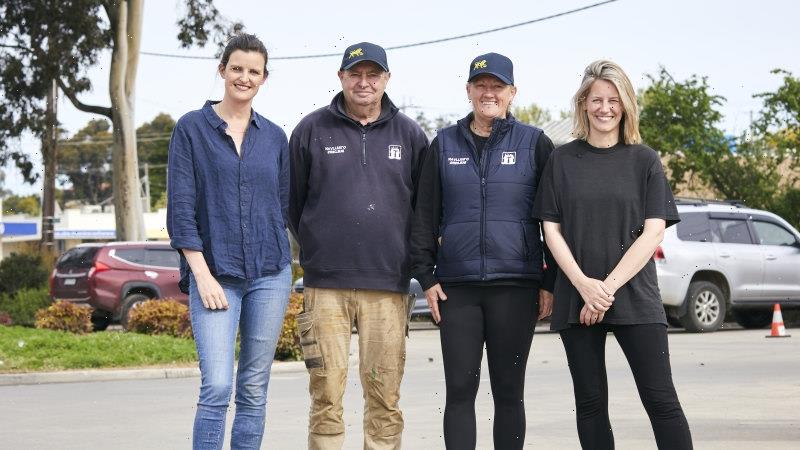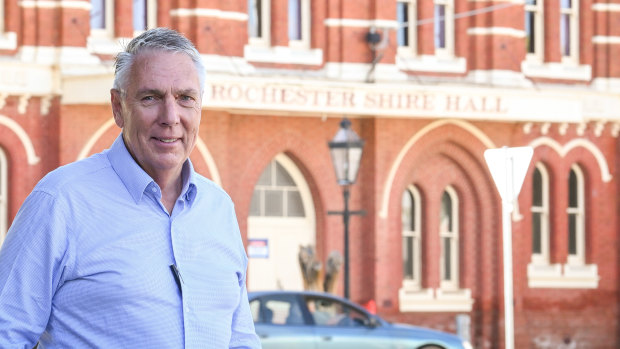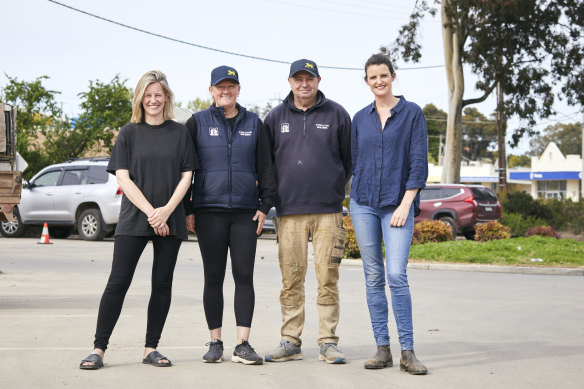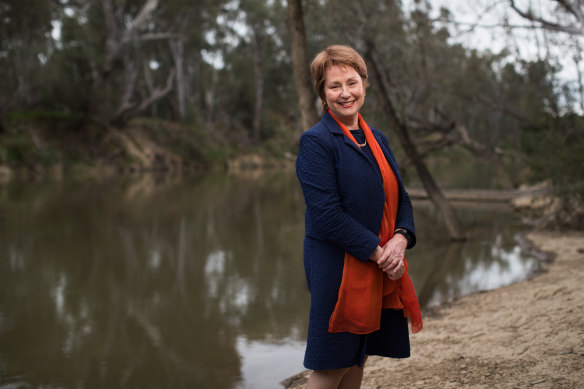It was a victory four years in the making that began with soul searching in the immediate aftermath of the 2018 Victorian state election.
Victorian Nationals leader Peter Walsh and state director Matthew Harris heeded the warnings of that campaign to preselect better quality candidates and better understand the concerns of regional Victoria to turn around the party’s dwindling fortunes.
Nationals leader Peter Walsh says the party has worked hard to reinvent itself as a party that better represents modern regional Victoria. Credit:Eddie Jim
On November 26, 2022, their efforts paid off.
The Nationals won three new lower house seats, elected a second upper house member, lifted their primary vote, regained official party status in the Victorian parliament, achieved gender equality in caucus, and pulled off a major political feat: defeat a first-term independent MP.
“The last four years was a continuation of the reinvention of the National Party from the perception we are a farmers’ party … to being a true champion of all of regional Victoria: regional towns, cities and our rural communities,” Walsh said.
“It’s not what we’ve just done during the election campaign, but what we did during the whole term, and particularly making sure that we were focused not just on the agriculture sector, but tourism, service, education and health.”
The Coalition, which by the next election would have only been in government for 11 of the past 44 years, is in a perilous position after November. It was unable to make any meaningful ground on the Labor Party, which won 56 seats in Victoria’s 88-seat Legislative Assembly.
The Liberal Party now holds 18 seats (although it is expected to pick up the seat of Narracan in a supplementary election this month), down from 21 in the last parliament, and it is grappling with how to appeal to women, younger people and a wider demographic.
But there are salient lessons from the Nationals for the Liberal Party on how to broaden your appeal, reinvent your brand to better reflect modern Australia, and elect more women to parliament without quotas or formal targets.
Walsh is hesitant to give gratuitous advice to the Liberal Party. Instead, he is at pains to point out that the seeds of an election victory are not planted during the election campaign but over the entire parliamentary term.
“Nationals MPs are very clear that their first role as an MP is to be the champion of their electorate and work through the constituent issues that come through their office,” Walsh says.
“Too often you see MPs who [think] it’s all about them and their role in parliament, rather than the fact they’re elected to represent their electorate … It’s a very good grounding to come home from parliament, stand on the boundary line at a footy game, and understand what’s going on in your community.”
On election night over a month ago, when the Nationals trounced the independents to reclaim the regional seats of Mildura, Shepparton and Morwell, the party’s state director Matthew Harris breathed a huge sigh of relief. He didn’t think it was an impossible task, but nor did he assume it was a fait accompli.
Independent MPs are notoriously difficult to knock off, and the redistribution in Morwell had made it a notional Labor seat.
Harris decided to focus on a few things heading into the 2022 state election: preselecting good quality candidates (preferably women); investing in good quality research throughout the campaign; reinventing the brand of the Nationals; heavily focusing on those three must-win regional seats; and trusting that the current crop of Nationals MPs would work hard in their communities.
The first has been a long-standing problem for centre-right parties in Australia.
Unlike the Labor Party which has quotas for female MPs and relies on a factional system to deliver gender equality in caucus, the Nationals and Liberal parties have been generally opposed to the idea because they have a grassroots democratic system in which branch members choose their local candidates.
Women make up just a third of the Liberal party room.
Walsh and Harris decided to tackle the problem.
Party elders, including Walsh and Harris, travelled across the state to speak with branch members – predominantly older male farmers – about the need to diversify the party’s appeal and shake off the perception it was the “farmers’ party”.
Harris says it was a tough slog over four years but when nominations opened for National Party preselection, and “high-quality” candidates had come forward, branch members did not see Walsh and Harris’ wishes as an imposition. Instead, they embraced the candidates.
Annabelle Cleeland, Sandra O’Sullivan, Gerard O’Sullivan and Steph Ryan during the flood clean up in Seymour on October 18.Credit:
“It was a four-year process: we talked a lot, we socialised a lot, we went around all over the state talking about the sorts of issues people wanted to hear from us,” Harris says.
“We had to explain that we can’t just be the farmers’ party and that we have to field candidates who are different, and who aren’t just white, male farmers. That’s a hard thing for the membership to hear, but we did a lot of research to back us up, and we took everyone on a journey about how we do things in a different way.”
Jade Benham, who won the seat of Mildura, was the mayor of Swan Hill Rural City Council and ran a small business specialising in digital media.
Kim O’Keeffe, who won Shepparton, was mayor of Greater Shepparton City Council and the owner of a small business.
Martin Cameron in Morwell ran his family’s small plumbing business.
Annabelle Cleeland, who replaced Steph Ryan in Euroa, is a former journalist, while new upper house member Gaelle Broad was a former political staffer, but most recently worked at a bank.
Harris also partly credits the party’s decision to heavily invest in a research program. It was the first time in recent National Party history to spend money on qualitative research, including focus groups.
After the 2018 election, the Nationals plotted where their “base” lived and determined that those who lived closer to the centre of a regional town were less likely to vote for the party. They then started examining what those people, predominantly younger families, wanted their local state MPs to be talking about.
Leanne White, from Insightfully, conducted the Nationals’ research program, and sat through countless face-to-face focus groups, asking people what made them tick and why.
She believes the party’s success on November 26 came down to several factors: the preselection of “good, strong, local” candidates; its brand as a team of MPs who fight for regional Victoria; and MPs who talk about the issues that matter in their local communities.
She also says her research showed a strong anti-Daniel Andrews sentiment in regional Victoria.
“It became clear to voters that some of these independents were essentially in Dan Andrews’ pocket based on their voting records,” White told The Age. “This became a problem for some incumbents because there was a huge dislike for Dan Andrews in regional areas overall … voters felt he and Labor had failed regional Victoria.”
When the regional focus groups were asked what they believed the Andrews government thought about them, voters said they felt the premier and the government thought regional Victoria ended at Bendigo, Ballarat and Geelong.
“Looking to the future, the National Party will need to appeal to a range of voter groups,” White says. “They will be looking at how they can increase their vote among groups of younger and middle-aged voters.”
Unlike the Liberal Party, the Nationals start with an advantage: they don’t have a “women problem” the way the Liberals do, according to Resolve Strategic director Jim Reed, with women just as likely as men to vote for the junior Coalition partner.
And while they need to be mindful of their ageing base, Reed says, they are not in immediate danger like the Liberal Party because regional areas tend to skew much older.
“The Nationals managed to increase their representation in parliament by 50 percent at the cost of independents, whereas the Liberals’ vote gains didn’t translate into any seats and they have shown themselves to be more vulnerable to teal independents,” Reed says.
“Part of this success lies in the natural need for Nationals MPs to be quasi-independent, representing the unique interests of large swatches of [the] country. This shows how the Liberals might defend against teal independents in inner-city seats.”
Harris acknowledges that it is simpler for the Nationals to run hyper-local campaigns: they run in only a handful of seats that, generally, still have their own media markets, and they are not in the business of appealing to half the population across the entire state.
They were able to run a campaign in Mildura that entirely focused on healthcare, while running a separate parallel campaign in Morwell that focused on jobs and the shutdown of the power and timber industries.
Regional communities also tend to know their local MPs far better than Melburnians.
Former Shepparton MP Suzanna Sheed said her victory in 2014 and 2018 had proved the Shepparton was no longer a National Party stronghold and could be won in the future by another independent. Credit:Jason South
Monash University senior politics lecturer Dr Zareh Ghazarian said the Nationals, although conservative, tended to be less ideological and more pragmatic about issues.
“They decide on a policy and they move from there,” Ghazarian says. “They’re able to present a much more united front … but I think the strength of the performance of the Nats this time around was that they were able to get seats off independents, which is quite hard. Once an independent wins a seat, it’s really hard for an established party to reclaim that seat.”
Ali Cupper, the former first-term independent MP for Mildura, declined to be interviewed but in a Facebook post last month said she and her team had done “remarkably well” against massive political headwinds, including a pandemic, “angry opponents, and a million-dollar-plus big-party war chest”.
Former Shepparton MP Suzanna Sheed, who was first elected in 2014, said she would not run at the next election, but her two-term victory had shown an independent could break the Nationals’ stronghold in the regional city.
“The Nationals purport to represent regional Victoria, but they don’t,” Sheed tells The Age.
“They seem to be addicted to being in opposition, they don’t have the guts to separate off from the Liberal Party at a time like this when they can work with the Labor government on some important issues. They’ve had only four years in government over the last 22 years. That’s extraordinary, and we tolerate that in the regions to vote for people who have no effective voice.”
The Nationals will now focus on breaking Labor’s stronghold in the regional cities of Ballarat, Bendigo and Geelong. They will also target the regional electorate of Ripon, which Labor’s Martha Haylett won off the Liberals’ Louise Staley.
Our Breaking News Alert will notify you of significant breaking news when it happens. Get it here.
Most Viewed in Politics
From our partners
Source: Read Full Article



